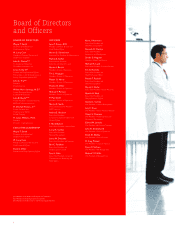Community Health Systems 2015 Annual Report Download - page 20
Download and view the complete annual report
Please find page 20 of the 2015 Community Health Systems annual report below. You can navigate through the pages in the report by either clicking on the pages listed below, or by using the keyword search tool below to find specific information within the annual report.• are located in an area with the potential for service expansion,
• are not located in an area that is dependent upon a single employer or industry, and
• have financial performance that we believe will benefit from our management’s operating skills.
Occasionally, we have pursued acquisition opportunities outside of our specified criteria when such
opportunities have had uniquely favorable characteristics. In addition, in recent years, we have been successful in
acquiring multi-hospital systems in larger metropolitan areas. We believe the acquisition of certain hospitals
located in select urban or other geographic regions can provide additional opportunities for increased services
and leveraging of our existing presence in some regions as well as reduced costs through shared resources.
While no hospital acquisitions closed during 2013, in July 2013 we announced that we, one of our wholly-
owned subsidiaries, and HMA had entered into an Agreement and Plan of Merger (which we subsequently
amended on September 24, 2013). On January 27, 2014, we completed the merger with HMA, which at the time
of acquisition owned or leased 71 hospitals. In addition to the HMA hospitals, during 2014 we acquired four
other hospitals located in Ocala, Florida; Sharon, Pennsylvania; Natchez, Mississippi; and Gaffney, South
Carolina. No hospital acquisitions closed during 2015.
We also apply these factors in the reverse to the hospitals currently in our portfolio to determine if there are
facilities that no longer meet our operating criteria. Separate and apart from the planned spin-off of the 38
facilities to Quorum Health Corporation, in 2015, we divested eight facilities, including two that were mandated
by the Federal Trade Commission in connection with the HMA transaction. As the delivery model continues to
evolve and we expand our existing networks of hospitals and facilities, we will also seek to divest facilities that
no longer fit our model but may be more valuable when realigned with other providers’ networks.
Disciplined Acquisition Approach. We believe that we have been disciplined in our approach to acquisitions.
We have a dedicated team of internal and external professionals who complete a thorough review of the
hospital’s financial and operating performance, the demographics and service needs of the market and the
physical condition of the facilities. Based on our historical experience, we then build a pro forma financial model
that reflects what we believe can be accomplished under our ownership. Whether we buy or lease the existing
facility or agree to construct a replacement hospital, we believe we have been disciplined in our approach to
pricing. We typically begin the acquisition process by entering into a non-binding letter of intent with an
acquisition candidate. After we complete business and financial due diligence and financial modeling, we decide
whether or not to enter into a definitive agreement. Once an acquisition is completed, we have an organized and
systematic approach to transitioning and integrating the new hospital into our system of hospitals.
Acquisition Efforts. A key part of our strategy involves establishing a broader presence in our states and
markets of operation and expanding and strengthening our regional networks where appropriate. Apart from our
acquisition of Triad hospitals in 2007 and HMA in 2014, most of our acquisition targets have been municipal or
other not-for-profit hospitals. We believe that our access to capital, ability to recruit physicians and reputation for
providing quality care make us an attractive partner for these communities. In addition, we have found that
communities located in states where we already operate a hospital are more receptive to our acquiring their
hospitals, because they are aware of our operating track record with respect to our other hospitals within the state.
At the time we acquire a hospital, we may commit to an amount of capital expenditures, such as a replacement
facility, renovations, or equipment over a specified period of time. Pursuant to a hospital purchase agreement in
effect as of December 31, 2015, we are required to build a replacement facility in York, Pennsylvania by July
2017. Estimated construction costs, including equipment costs, are approximately $125 million for this
replacement facility, of which approximately $5 million has been incurred to date. In addition, in October 2008,
after the purchase of the noncontrolling owner’s interest in our Birmingham, Alabama facility, we initiated the
purchase of a site, which included a partially constructed hospital structure, for a potential replacement for our
7
























